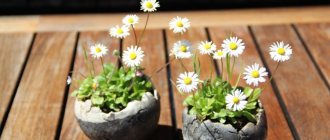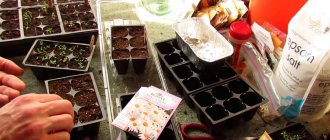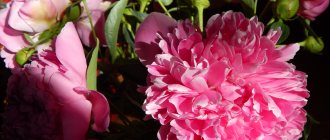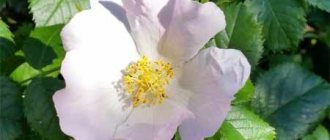Bluebells have been grown as a garden crop for a long time. Flower growers fell in love with them for their unpretentiousness and beautiful, but at the same time modest, ascetic flowers. The plant grows wild in almost all corners of the world; several hundred cultivated species and varieties have been bred, differing in appearance and flowering period. In this article we will look at the features of planting and caring for perennial bellflowers in the garden.
Description of the plant
Campanula (Campanula) is a genus of herbaceous plants in the Campanula family. It grows wild and is found almost everywhere; about 300 species have been cultivated. Translated from Latin, the name translates as “bell”, which is due to the characteristic shape of the buds.
Annual bells are used in gardening, but perennial types are most popular. Depending on the variety, the height of the stem varies from 30 to 150 cm, the leaves can be of various shapes, arranged alternately or in the form of a basal rosette. Flowers can be single, collected in racemes, paniculate inflorescences. The size and color of the buds is strikingly diverse. A huge number of different shades, textures and even shapes of bell flowers have been developed. After flowering, a seed capsule is formed, the planting material remains viable for up to 4 years.
In landscape design, garden perennial bells are used for various purposes. Large and voluminous species are used for planting as tapeworms, but more often the flowers are used to create multi-species compositions. Tall varieties are suitable for planting in the background in mixborders, rockeries, and low-growing varieties are planted in the foreground. Bells are used to frame borders, decorate buildings and fences.
Bell flower - description with photo
Representatives of the genus are herbaceous one, two or perennial plants, which are characterized by relatively rapid growth after planting.
Leaves often vary in shape on the same plant - larger and wider at the base of the stem and smaller and narrower ones higher up the stem. The edge of the leaf can be either whole or jagged. The leaves, flowers and stems of some species are covered with villi.
Garden bells vary in size: from low-growing, miniature types to tall varieties over one and a half meters in height.
TOP – 19 unpretentious long-flowering perennials
The root system is also different - it can be taproot, fibrous or creeping. For propagation by division, a vegetatively mobile creeping root system, which is characteristic of low-growing mountain bells, is suitable.
The decorative part of this plant is the flowers, which have a characteristic bell-shaped shape, but in some species they can be more elongated, goblet-shaped or star-shaped.
The flowers are solitary or collected in inflorescences, located either at the ends of the peduncles or along the length of the stem.
What colors are bluebells? The color of the flowers can be blue, violet, blue, pink or white, and there are two-color varieties.
The fruit is a capsule capsule containing numerous small seeds.
Types and varieties
Today there are about 300 varieties of bells, which differ in their flowering period, bush height and external features. The most popular perennial species:
- Broadleaf . A tall perennial, growing up to 1.5 m. It has a bare shoot, on which there are double-serrate leaves up to 12 cm long. Large axillary leaves are collected in a spike-shaped brush (see photo). Flowering is possible all season. The most spectacular varieties: Alba, Bruntwood, Macrantha;
- Carpathian . The bush reaches a height of only 30 cm. The flowers are single, reaching 6 cm in diameter. Flowering begins in the first half of summer and can last up to 8 weeks. Famous varieties: Alba, Celestina, Klip, Isabel, White Star;
- Milky-flowered . In the wild it can be found in the Caucasus and the countries of Asia Minor. The stem height varies from 50 to 150 cm depending on the variety. The flowers are usually white, up to 4 cm in diameter, collected in racemes. Flowering lasts from June to August. Varieties: Alba, Caerulea, Prichards Variety;
- Spot . It has a thin and fibrous stem, reaching a height of up to 50 cm. Flowers with a diameter of up to 6 cm have a pubescent goblet-bell-shaped shape and a characteristic dotted color. Famous varieties: Rubra, Alba nana;
- Takeshima bell . It grows wild in Iran and some regions of Korea. The bush grows up to 60 cm, there is a developed group of rosette leaves. Shoots can be creeping or ascending. The flowers are drooping and almost always double. Varieties: Beautiful Trust, Wedding Bells;
- Peach-leaved . A medium-sized species, the height of the stem reaches 1 m. The bell received its name because of the shape of the leaves, reminiscent of peach. The flowers are large, growing up to 5 cm in diameter. Flowering is long, from June to August. Varieties: Bernice, Exmaus, Snowdrift.
Gardeners are fond of bells for their diversity of species. The following varieties and hybrids are also grown as a cultivated plant: Sarastro, bellflower of Komarov, Pozharsky, Chamisso, spiral-leaved (spoon-leaved), coarse-leaved and others.
Tall bluebells
- Broad-leaved bellflower (C. latifolia) more than 1 m high, the inflorescence is loose, racemose, apical. The flowers are large, purple or white. In culture since the end of the 16th century.
- Peach bell (C. persicifolia) 0.5–1 m high, paniculate inflorescences, few flowers. The flowers are large, blue or white. Terry forms are available. In culture since the middle of the 16th century.
- The crowded bell (C. glomerata) is 30–60 cm high, the inflorescences are dense, capitate, apical and axillary. The flowers are small, purple or white. In culture since the middle of the 16th century.
- Campanula (C. lactiflora) reaches 0.5–1.5 m in height, the inflorescences are multi-flowered, highly branched, lush. The flowers are small, milky white, sometimes slightly lilac. A good honey plant. In culture since the beginning of the 19th century.
Selection of location and conditions of detention
Bells are unpretentious and can grow and bloom even with minimal care. When growing perennial species, it is important to choose the right place for planting, since the health of the plant, the quality and abundance of flowering depend on it.
Lighting and location
Perennial bells prefer areas with moderate indirect light, but grow best in light partial shade. When planted in an open, sunny place, flowering is shorter, and the color saturation of the petals decreases. Flowers do not tolerate stagnant moisture, so bells should not be planted in wetlands, near bodies of water or in proximity to high groundwater.
Tall varieties are convenient to plant next to a fence or building to avoid stem breakage due to strong gusts of wind. It is not recommended to grow perennial bells in close proximity to shrubs or trees, as the root system receives less minerals and water.
Temperature
Bells are highly frost-resistant and can survive frosts and sudden temperature changes. They grow and develop quickly in a wide temperature range from 15 to 22°C. In warmer conditions, their metabolic processes slow down and there is a risk of leaves and flowers wilting. In winter, the optimal temperature is 5-10°C. If during wintering the plant is in warmer conditions, then flowering in the next season may be less pronounced, and there is a risk of the bell dying in the spring.
Air and humidity
Medium-sized and low-growing varieties can be grown without any support. For varieties with tall stems, it is recommended to tie them to avoid breaking the bush due to strong winds. The plant has strong immunity, can grow in regular drafts, and does not require greenhouse conditions for flowering.
Bluebells react poorly to high soil and air humidity. When water stagnates, rot develops on the root system, which leads to the death of the bush. For cultivation, you definitely need well-permeable soil. Spraying is not required, you just need to follow the watering regime.
Priming
To plant bells, you should select an area with loose and well-drained soil. The plant does not tolerate stagnant water; it is not recommended to plant it in lowlands, clayey and swampy substrates. The soil should have a slightly alkaline or neutral acidity level. It is recommended to organize a drainage irrigation system in advance, which is a good prevention of waterlogging of the root system and reduces the risk of rotting.
Legends and properties
Bellflower can be used as a medicine for inflammation, take no more than 2 tablespoons 3 times a day on an empty stomach or simply rinse the mouth. The stems and leaves are useful not only for medicinal purposes, but also contain vitamins B and C.
The sad thing is that picked wild bells die instantly; water hardly helps them. The leaves and stems of large-leaved bells are used in food: both raw and boiled; tall root - you can also eat it; an infusion of plants relieves pain from ulcers, helps to relax, the leaves can be used to cleanse skin and wounds, flowers keep evil away from the house, and if a girl heard the ringing of bells on the night of Ivan Kupala, she can safely make a wish for her betrothed.
The belief says that these flowers bring joy and happiness, provide elderly people with a peaceful old age, and help girls find strong love; in addition, they have a love spell; a young lady just needs to pick a flower and attach it to a shutter to lure her beloved.
There is a very beautiful legend: flowers swaying in the wind know all the forest news, and the gnomes who walk through the clearings at night listen to them. One of the Italian stories tells about a bishop who, seeing these flowers, ordered a church bell to be made from copper in their likeness; when it was ready, it sounded unusually pleasant and ringing; it is generally believed that the bell is the main decoration of the church, and the bells are the forest.
Reproduction methods
In garden conditions, bells can be propagated in three main ways:
- Seeds . This method is rarely used, since with the seed propagation method, varietal qualities are lost, and the plant practically does not bloom in the first season. Not suitable for terry varieties;
- Cuttings . Planting material is prepared in March or early April. Cuttings are prepared from healthy and strong young stems, which are then planted in a container with fertile soil for subsequent rooting. After the appearance of strong roots, you can transplant into open ground;
- Bush division . Suitable for adult bells, the method is often combined with a planned transplant. In the fall, the bush is dug up, and then divided into 2-3 parts and planted in a permanent place.
Despite the difficulty of seed propagation, this is often the only way to get new types of bells on your site. Planting material in the store is often represented by seeds.
A little about bells: brief information
The genus of bells (Campanula) includes 300 species. These are cosmopolitan plants that are found in different latitudes and climatic zones. They delight with little blue islands in the mountains, forests and meadows. Bells are characterized by:
- herbaceous form;
- alternately arranged, simple leaves;
- different heights: from low to large forms;
- coloring of the corolla in various blue shades;
- inflorescence in the form of a panicle or brush;
- sometimes - a single arrangement of flowers;
- fruit in the form of a capsule filled with small seeds.
Marina Ivanova
He is an expert in his field and an experienced flower growing practitioner.
Ask a Question
Note: The name of the bell is telling: it really looks like a bell. The variety of natural species and created varieties allows each gardener to find his own variety of garden bell, which is traditionally grown from seed.
When to plant
Bells are planted in open ground when there is no threat of spring frosts. In warm regions, you can plant seeds or cuttings from the end of April or early May; in cold regions it is recommended to wait until the end of May or even the beginning of June.
In the south, perennial bluebells can be planted for the winter. The procedure is carried out until the first half of October, then the planting must be covered with peat and fallen leaves with a layer of up to 20 cm. To obtain seedlings, bells are planted at home in the first half of March.
Preparing for landing
Before planting, seeds should be treated with a 1% solution of potassium permanganate for disinfection; they have good germination, so there is no need to use growth stimulants. After processing, they need to be dried with a dry cloth or napkin.
For planting, you can use a ready-made substrate for flowering crops or prepare the soil yourself. The optimal composition is fertile soil, humus and river sand in a ratio of 2:1:1. For planting, only a common container is required; bells are not picked.
Growing bells from seeds
How to sow seeds
Bluebell seeds do not require preliminary preparation before sowing. They can be sown directly into the ground in May or before winter in October. But if you want them to bloom this year, sow them as seedlings in March.
Since the seeds are very small, they are laid out on the surface of a light, loose, permeable substrate, previously well moistened and consisting of humus, turf soil and coarse sand in a ratio of 3:6:1. There is no need to add fertilizer to the substrate. The seeds are lightly pressed to the ground, sprayed with water from a spray bottle, and then the container is covered with film. Contain crops at a temperature of 18-20 ºC. Shoots may appear in two to three weeks.
- Smoking tobacco: cultivation, collection and storage
Seedling care
As soon as the seeds begin to germinate, move the container to a bright place, protected from direct sunlight, remove the film and care for the bell seedlings as you would any other flower seedlings: water when the top layer of the substrate dries, loosen the soil around the seedlings, and when they turn three weeks and their first leaves will develop, the seedlings dive into a large container at a distance of 10 cm from each other. Two weeks after picking, feed the seedlings with liquid complex fertilizer in low concentration
Planting process
The seed method of planting bells has some features. Step-by-step algorithm:
- Fill the container with substrate, lay a drainage layer 3-5 cm thick on the bottom. It is convenient to use expanded clay or pebbles as a material. After this, the soil should be watered generously with warm water.
- The seeds are sown to a depth of 2 cm, then sprinkled with a layer of fertile soil and watered again.
- The container with seedlings should be kept in a well-lit place at a temperature of 17-20°C. To speed up the emergence of seedlings, it is advisable to use a glass or film cover. No additional lighting is required.
- The first shoots appear 10-14 days after planting; in apartment conditions they need to be kept for another 20-25 days for the first leaves to form and the root system to become stronger. During this time, you need to monitor moderate soil moisture, loosen the soil and remove diseased leaves.
- The planting area is dug up to a depth of 20 cm, planting holes are dug with an interval of at least 15 cm between plants.
- Replanting to a permanent location should be carried out in dry and warm weather. After transplanting the seedlings, the plants need to be watered generously with warm water and nitrogen fertilizing, which is suitable as organic matter - peat or mullein solution.
After planting, the flowerbed needs to be mulched; there is no need to provide shelter from the cold, since the bells have quite strong frost resistance. It should be borne in mind that with this method, flowering may not occur in the first year.
Gargan bell (Campanula garganica, syn. C. elatines var. garganica)
Creeping rhizomatous perennial from Southern Europe.
Campanula garganica
Its parameters: height 5 cm, width up to 30 cm. Leaves up to 3.5 cm long from kidney-shaped to oval-heart-shaped. The flowers are star-shaped, bright blue, up to 2 cm in diameter, in racemes. Blooms profusely in summer.
Decorative varieties:
• 'Dickson's Gold', f. aurea - yellow leaves, blue flowers;
Bellflower 'Dickson's Gold', appearance. Photo from growsonyou.com. Close-up of its flowers. Photo from edrom-nurseries.co.uk
• 'WH Paine' - lavender-blue flowers with white centers. The British call it Adriatic bellflower.
Bellflower 'WH Paine', appearance. Photo from alpinegardensociety.net. This is a closer portrait. Photo from bellflowernursery.co.uk
All of them form low cushion-shaped turfs.
Rules for caring for and growing in the garden
Perennial bells are loved by gardeners for their unpretentiousness and ability to bloom in almost any conditions. For these plants, it is necessary to follow the watering regime, apply fertilizing on time and prepare the planting for winter.
Watering
Bluebells practically do not need watering. Regular watering of the planting is necessary only in dry and arid weather; at all other times, you should monitor the condition of the soil, preventing it from becoming waterlogged or drying out. As a rule, watering is carried out 1-2 times a week; if there is precipitation, it is not necessary to water the bells. The moisture should be soft and settled; it is advisable to use rain or melt water.
Top dressing
For the first time, fertilizers are applied in the spring before the start of the active stage of the growing season, for which nitrogen compounds are used, for example, urea (urea) at the rate of 15-20 g/1m2. Closer to flowering, it is recommended to add any liquid complex composition for ornamental flowering plants, but you can also use nitrophoska 20-25 g/m2. On poor soils, superphosphate is added to the soil in the fall in a volume of 40-50 g/m2.
Loosening, mulching
To maintain soil aeration, loosening to a depth of 3 cm is carried out as a dry crust appears on the upper surface of the soil. It is advisable to carry out the procedure after each watering to avoid water stagnation. During the season, it is necessary to remove weeds in a timely manner; it is advisable to maintain a layer of mulch. It is supplemented as necessary; the mulching thickness should not exceed 5 cm to avoid overheating of the roots.
Pinching, pinching, pruning
The formation of bells is carried out for sanitary purposes. Throughout the growing season, I remove all damaged, yellowed and deformed leaves and shoots. It is more convenient to carry out the procedure by hand, since all parts of the plant are weak and easily removed. Experienced flower growers also recommend pinching out all the formed buds in the first year of growth in order to enhance the flowering process for the next season.
Transfer
Not all types of bells tolerate transplantation well, so it is advisable to carry out the procedure as rarely as possible. The plant can grow comfortably in one place for 4-5 years, then the intensity of flowering decreases, the shoots form weak and thin. Transplantation is carried out in the fall after flowering and the formation of seed pods. First, the bush must be cut to a height of up to 20 cm, and then dug up and, together with a lump of earth, moved to a new place. After this, the plant should be fertilized with organic fertilizer and the bush should be prepared for winter.
Caring for flowers in summer
Bell Raspberry ringing
One of the attractive qualities of bluebells is their ease of care. It consists of regular watering during hot weather, further loosening the soil around the flowers, and removing weeds. Tall varieties will need staking or securing to supports.
- Fertilizing is carried out in the spring with nitrogen fertilizer to increase the vegetative mass and earlier flowering.
- During budding in early summer, phosphorus or complex additives are needed.
- In autumn, potassium fertilizers are applied to increase the winter hardiness of the plant.
- If a particular variety prefers the soil to an alkaline, neutral reaction, it is important to reduce the existing acidity with the help of ash.
- In summer, moderate application of rotted humus is appropriate.
In order to extend the flowering time, it is necessary to remove fading inflorescences. At the same time, all faded shoots of tall varieties are cut off. If you plan to collect seeds, then browned, but not yet opened, boxes are left on the plant.
Wintering
After flowering has finished and the seeds have been collected, the bell bush should be pruned at the root. To avoid death from frost, the plant should be covered with a layer of compost or peat up to 20 cm high. In cold regions, the plant should be additionally covered with dry leaves or spruce branches, but agrofibre can also be used. Manure and humus for winter shelter can only be used on depleted soils in order to avoid an excess of nitrogen in the spring.
If you plan to use the seeds, you need to collect them before they are fully ripe, as they begin to open and fall off. After collecting, they need to be dried and the seeds removed, which should be stored in a dry and warm place. They remain viable for up to 4 years.
Perennial bells after flowering
How and when to collect seeds
If you want to get seeds of your favorite species, then do not wait for the boxes to open; cut off the inflorescences left for the seeds in advance, as soon as the boxes acquire a brown tint, and ripen them in a ventilated, dry room.
Preparing for winter
Planting and caring for perennial bluebells is no different from growing annual or biennial varieties, except that they need to be prepared for winter. At the end of September or beginning of October, the stems of all bells are cut off at the root. This completes the care of annual flowers. As for biennial and perennial species, many of them overwinter without shelter, but southern species need to be covered with dry leaves or covered with spruce branches. Tall bells are covered with a layer of humus or dry peat 15-20 cm high. This will be enough for perennial bells to survive the winter.
Features of cultivation
Perennial bells have strong immunity and vitality, and are rarely affected by pests and diseases. As a rule, infection occurs when a flower is grown in one place for a long time, care technology is not followed, or there is an excess or lack of minerals in the soil. Diseases include both fungal and bacterial infections of roots. To prevent diseases for adult plants, it is recommended to treat them with a 0.2% solution of Fundazol in spring and autumn.
With high humidity, there is a risk of pests - the slobbering frog (leafhopper) and slugs. Large populations of these insects can be reduced mechanically, such as by removing them by hand. For control and prevention, both traditional methods (ash solution, infusion of garlic or onion) and chemical preparations are used - Aktara, Karbofos, Intavir and others.
Perennial bells are a real boon for the garden. The plant is unpretentious, develops quickly and blooms profusely almost all summer. To maintain health and flowering, minimal care should be taken. Due to the wide variety of species, this crop can be used for a wide variety of landscape design solutions.
Diseases and pests
Saxifraga: description, types and varieties, propagation, growing from seeds, planting in open ground, care (110+ photos & videos) + reviews
The culture attracts gardeners because it has strong immunity to diseases and pests. However, sometimes this problem also affects bells, especially often when the rules of agricultural technology are not followed.
The appearance of rust is indicated by yellow or brown pads on the inside of the leaf. Leaves damaged by the disease dry out. Mechanical elimination of the affected fragments will help revive the plant. And also in spring and autumn, the diseased specimen should be treated with a 0.2% Fundazol solution.
Having noticed the browned parts of the plant, which gradually soften, rot, and a gray coating forms on them, we can assume that the bell has become a victim of rot. An effective control method will again be a 0.2% solution of Fundazol. Powdery mildew is indicated by the formation of a whitish coating. As a preventive measure, the crop is treated before flowering with a solution of copper sulfate in a proportion of 100 g per 10 liters of water.
They love to feast on the leaves and flowers of the presented crop. These pests are the result of non-compliance with planting and care conditions. For example, they often affect dense plantings and appear as a result of poor-quality soil tillage and untimely removal of weeds.
Typically, gardeners use metaldehyde to control slugs. In addition, an effective way is to manually assemble individuals. Some summer residents specifically populate the area with frogs, lizards, and hedgehogs, which will help get rid of slugs in a natural way.
Sometimes the roots are damaged by mole crickets. To rid the plant of this scourge, the soil should be thoroughly loosened throughout the growing season. Loosening will help destroy the underground passages of the insect, destroy eggs and larvae, and make it difficult to get to the roots. Try to avoid this type of feeding, such as mullein - it attracts mole crickets.











